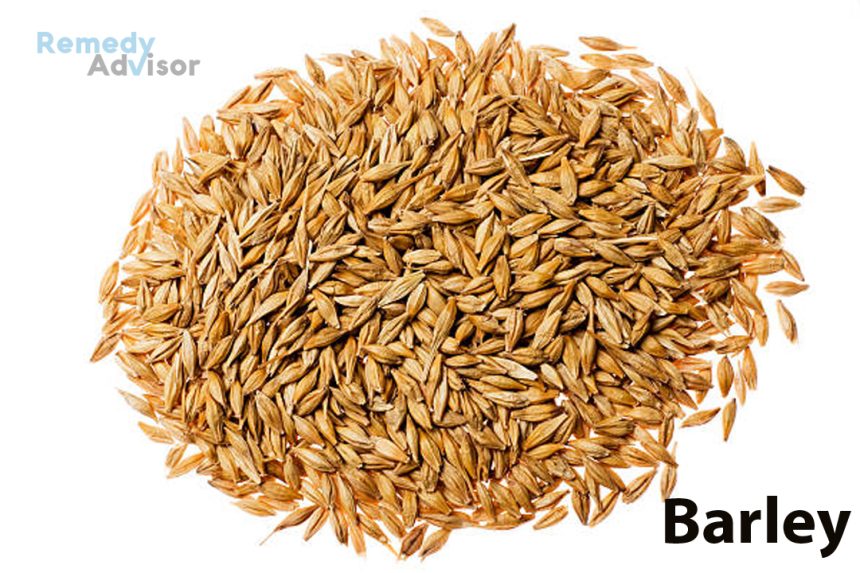When Americans mention grains, they are usually discussing wheat, oats, rice, or corn. But, of course, there are others. One of these is barley, which is believed to be one of the oldest grains. According to historians, it was used by the ancient Egyptians, and Christopher Columbus brought it to the Americas in 1494.
Today, in the United States, the most common type of barley is pearled. Even though the outer hull and bran have been removed, since barley contains fiber throughout the grain, pearled barley still contains a good deal of soluble and insoluble fiber. In fact, in contrast to a half-cup of cooked brown rice, which contains 1.75 grams of total dietary fiber, a half-cup of cooked barley contains 3 grams of total dietary fiber. But, on the shelves of supermarkets, where it typically sits next to rice and dried peas, it barely has a presence. It may be shocking to hear that most of the barley grown in the United States is used for preparing malt for brewing beer and for animal feed. Should Americans be using more barley?
Cardiovascular health
During 2004, researchers at the Diet & Human Performance Laboratory, Beltsville Human Nutrition Research Center, Agricultural Research Service of the U.S. Department of Agriculture, had two important studies published on the lipid lowering potential of barley. In a study published in the Journal of the American College of Nutrition, the researchers attempted to determine if barley, as a source of soluble fiber, would lower the rates of cholesterol in eighteen men between the ages of 28 and 62 who had moderately elevated levels of cholesterol. After five weeks of barley consumption, they found significant improvement in the total and LDL (bad) cholesterol levels. The researchers noted that, “boosting soluble fiber through the ingesting of barley in a healthy diet may decrease heart risk factors.”
An article that appeared in The American Journal of Clinical Nutrition describes similar research, only this time the researchers studied both men and women with mildly elevated levels of cholesterol. There were nine postmenopausal women, nine premenopausal women, and seven men. Again, after five weeks of barley consumption, the subjects experienced significant reductions in their total and LDL cholesterol. The researchers wrote, “The addition of barley to a healthy diet may be effective in lowering total and LDL cholesterol in both men and women.
In a study published in 2006 in the Journal of the American Dietetic Association, the same researchers compared the effects of diets high in predominately insoluble fiber (brown rice and whole wheat) to those with predominately soluble fiber (barley) on the blood pressure readings of men and women with mildly elevated cholesterol levels. Both diets proved to be useful for lowering blood pressure. The researchers noted, “Increasing whole-grain foods, either high in insoluble or soluble fiber, may decrease blood pressure and may assist to manage weight.
A study published in 2007 in the British Journal of Nutrition investigated the effects of the soluble fiber beta-glucan, which is found in abundance in barley, on the cholesterol levels of men and women with higher levels of cholesterol. Researchers found that the inclusion of concentrated barley beta-glucan (BBG) in the diet led to significant reductions in the levels of total and LDL cholesterol. The levels of HDL (good cholesterol) remained unchanged. Commenting on the study, the researchers advised, “food products containing concentrated BBG should be considered an effective option for improving blood lipids.”
In a Canadian-based study published in 2006 in The American Journal of Clinical Nutrition, researchers attempted to determine if participants in “real world conditions” could effectively lower their levels of elevated cholesterol. The participants were placed on a diet that included a number of cholesterol lowering foods, such as barley. After twelve months, over 30 percent of the 55 people who completed the study had lowered their cholesterol levels by more than 20 percent. The researchers noted that the results were, “not considerably unlike from their reaction to a first-generation statin taken under metabolically organized situations.”
For the past several years, certain whole-grain barley products have been able to claim that they may be useful in the fight against heart disease. According to the U.S. Food and Drug Administration, soluble fiber foods, such as barley, which contain at least 0.75 gram of soluble fiber per serving, may indicate that, “as part of a diet low in saturated fat and cholesterol, (they) may reduce the risk of heart disease.”
Blood sugar levels

In a study that appeared in 2006 in Nutrition Research, twenty men, who were mildly insulin resistant, ate different types of muffins, including muffins that contained varying amounts of soluble-rich barley beta-glucan. The men who ate the muffins with the most barley beta-glucan had the most significant reductions in glucose and insulin responses. The researchers believed that consuming adequate amounts of foods with beta-glucan may help control the rising rates of type 2 diabetes in the United States.
A similar study from Italian researchers was published in 2006 in the Journal of the American College of Nutrition. Researchers gave a group of ten healthy volunteers’ crackers and cookies made from either barley or whole wheat flour. The barley products contained 3.5 grams of beta-glucan per portion; the dietary fiber in the whole-wheat products was primarily insoluble, and it contained almost no beta-glucan. The researchers found that when compared to the wheat crackers and cookies, the barley products significantly reduced glucose and insulin response.
An intriguing study was published in 2007 in Diabetes Research and Clinical Practice. Hoping to understand why imprisonment tended to improve metabolic control in prisoners with type 2 diabetes, researchers conducted a retrospective study of the medicinal charts of 4,385 male prisoners in Fukushima Prison in Japan from 1998 to 2004. In addition to working eight-hour days, five days a week, Japanese prisoners ate diets that were high in dietary fiber that included boiled rice and barley, a food called mugimeshi. Because of improvements in their diets and lifestyles, while imprisoned, 5 of 18 prisoners who needs insulin and 17 of 34 who were cured with oral hypoglycemic means were capable “to stop their treatment and maintain good metabolic control.” As a result, the researchers concluded that “a well-regulated régime and long-term consumption of high dietary fiber might have favorable effects on metabolic control in patients with type 2 diabetes.”
Premenopausal breast cancer
Barley is filled with phytonutrients known as lignans, which are converted in the colon into enterolactone and enterodial, substances with mild estrogen like properties. In a study published in 2006 in the European Journal of Cancer Prevention, German researchers measured the concentrations of enterolactone (and genistein) in plasma samples from 220 premenopausal women and 237 controls. The researchers found that the women with the highest levels 13 of enterolactone had the lowest incidence of premenopausal breast cancer.
One caveat
Though barley is a healthy addition to the diet for the vast majority of people, those who are dealing with celiac disease or other forms of gluten intolerance should be very careful to avoid all barley products. Should barley be included in the diet? For most people, it is an excellent addition.







